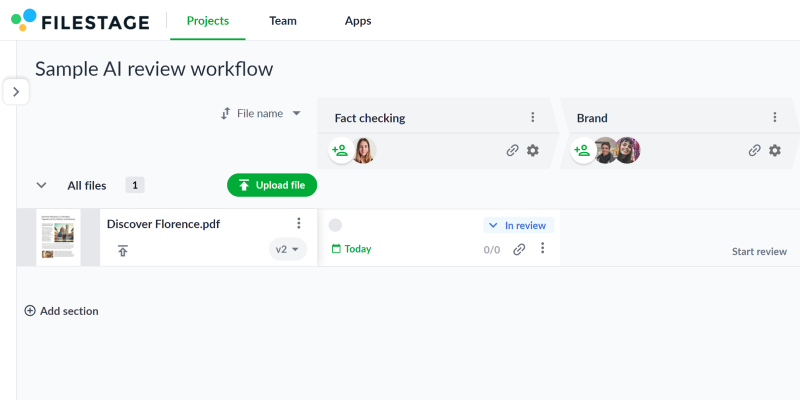Over the last 12 months, AI has taken the marketing world by storm.
We’ve all had a go at it, marveling at how it can generate complex images and swathes of text based on a simple prompt.
But when it comes to brand efficacy and compliance, it’s left a lot of us scratching our heads wondering (well, to put it plainly) what the hell do we do now?!
Over the next few minutes, we’ll cover five steps you can follow to build a review process for AI-generated marketing content. But first, I’d like to cover a few data points to illustrate why a robust review process is so important.
Marketers are quietly using AI to create content for brands
In December 2023, we surveyed 250+ marketing professionals about their experiences and opinions on AI. This all came together in our 2024 report: AI’s impact on creativity, self-esteem, and work-life balance.
One of our most surprising findings was that 42% use AI daily or weekly to create marketing content.
Here’s how that breaks down across different company types:
- Agencies – 52%
- Brands – 33%
- Freelancers – 51%
- Production companies – 36%
- Startups – 57%
This reveals that AI isn’t just something people are playing around with. It’s something designers, writers, and video editors are actively using in their day-to-day work.
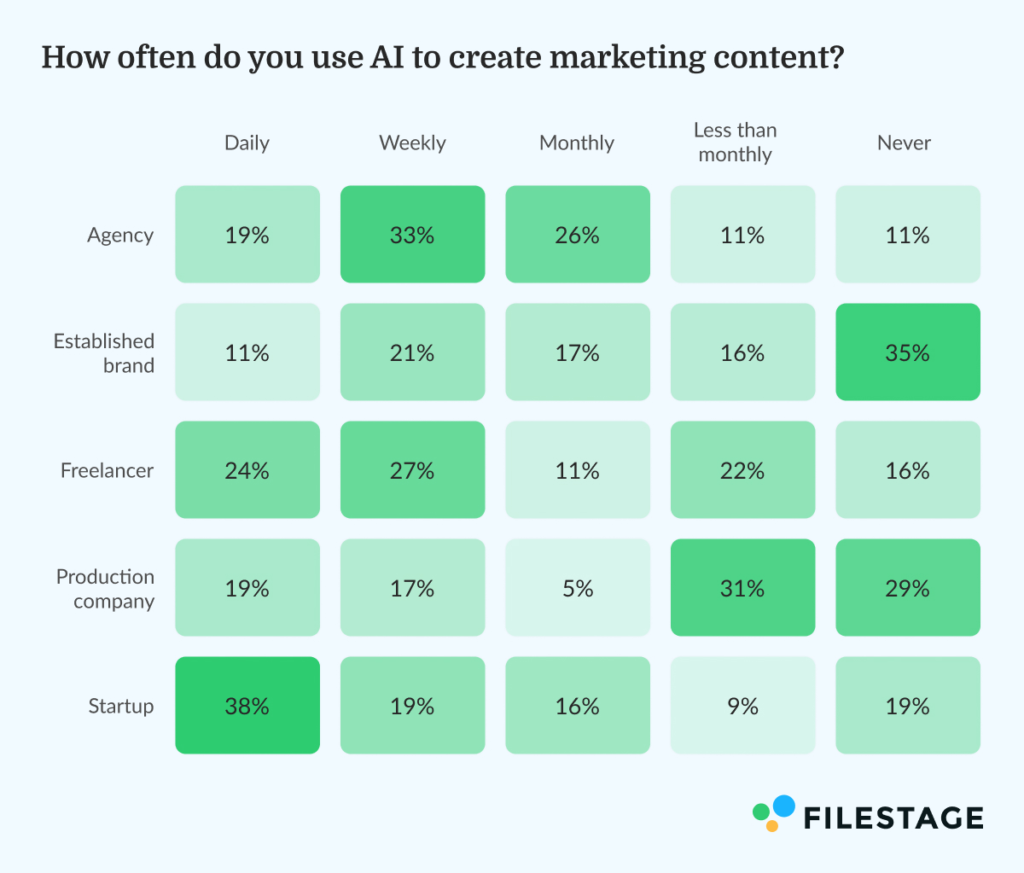
Is this a problem? Well, it could be. So we decided to dig a little deeper.
The next thing we wanted to understand is whether people were being transparent with their stakeholders about their use of AI.
This revealed that 2-in-3 haven’t told their manager or clients that they’re using it. And it also showed that people are more open about using AI with their teammates than they are with other types of stakeholders.
This suggests a serious blind spot for anyone reviewing creative work in 2024. So brands and agencies need to find ways to improve transparency with in-house creatives and freelancers.
And in new relationships where trust is still a question mark, they also need ways to detect AI-generated content with confidence. (Skip to step two for my recommendations!)
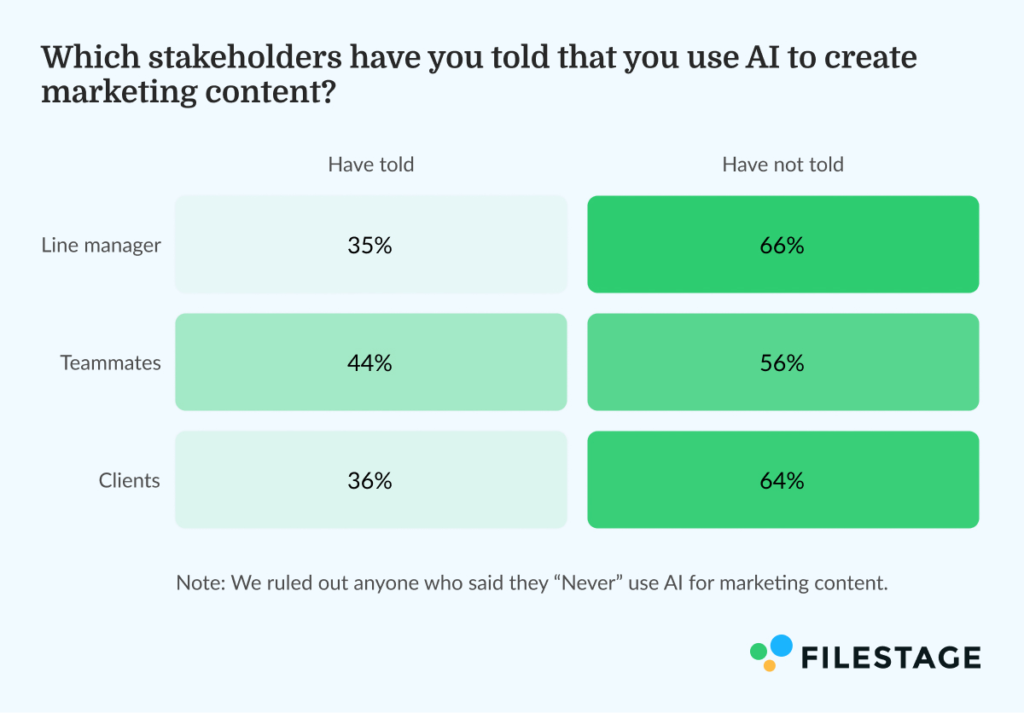
AI is great for productivity but puts quality at risk
We’ve all heard the claims about AI’s potential to boost productivity. So when asked about AI’s impact on different aspects of their work, we weren’t surprised to see that 83% feel it will have a positive impact on productivity.
People also feel positive about AI’s impact on profitability (62%) and creativity (59%) – though that last one was pretty contentious. One respondent said, “I think it will enhance our creativity more than ever before,” while another said, “it will decimate the industry and lead to more bland, safe content.”
That’s that settled then. Not.

When we talk about AI’s impact on creativity, we’re really talking about quality.
How is AI impacting the quality of work brands are putting out there? And can the people using tools like ChatGPT, Bard, and Bing be trusted to assess the quality of their results?
One outcome of our report shines a light on just how important this question is.
73% say AI is likely to help people take on tasks outside their skillset. That means SEO specialists generating articles instead of content writers. It means social media managers generating image posts instead of designers. And it means people making creative decisions that they don’t really have the expertise to make.
So, then, it’s no surprise that 62% say AI is likely to increase the importance of content reviews.

Five steps to build a robust review process for your AI-generated content
To truly overcome the challenges of AI-generated content, brands need a robust and purpose-built review and approval process.
This should have a few clear goals:
- Identify when AI has been used without prior agreement
- Make sure content is accurate, on brand, and compliant when AI has been used
- Share knowledge about which prompts deliver the best results
To help you achieve all three, we’ve put together five easy and actionable steps for you to follow.
Let’s dive in.
1. Create a culture of transparency and honesty around AI content
Whether you like AI or not, your teammates and freelancers are going to use it – and we’ve got the data to prove it. So the very first thing you need to do is encourage people to be open about that fact.
If you set a rule saying AI marketing tools must never be used, people simply ignore it and use it in secret. Maybe not everyone, but some will. Far better, then, to work on building a transparent culture around AI.
Here are a few things you could try:
- Show-and-tell sessions – Set up a fortnightly session where teammates can share real world examples of how they’ve been using AI to speed up their work. Together, you can discuss the benefits while making suggestions to minimize brand and compliance risks.
- Prompt libraries – Create a knowledge base in a tool like Notion where teammates can share their most effective prompts. This will help you increase the quality of your first drafts so you can maintain a consistent style for images and copy.
- Tagging content as AI-generated – Last but not least, always tag content to make it clear to reviewers where AI has been used and extra fact-checking will be required. You can do this by uploading your content to Filestage’s feedback tool and adding annotations before inviting your reviewers.
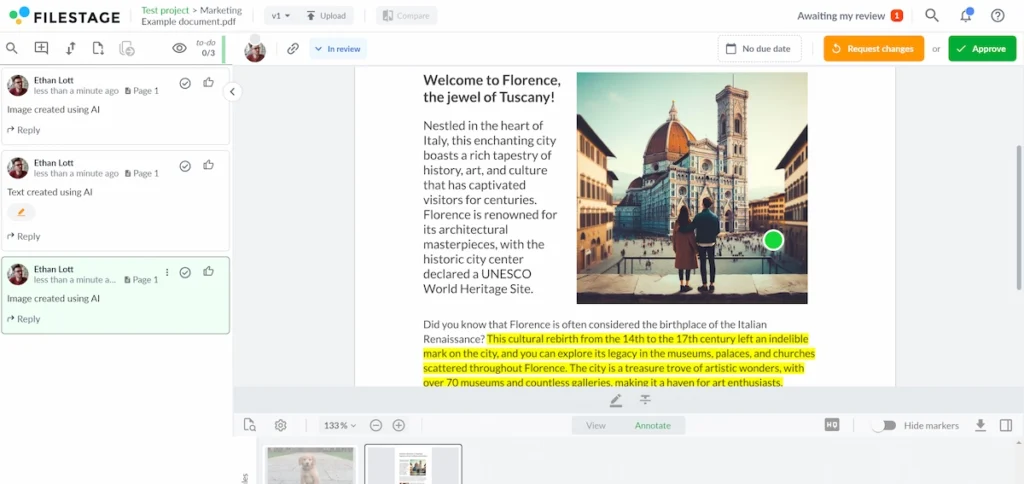
2. Use free detection tools to check if content was generated using AI
Step one was all about creating a culture of honesty and transparency around AI usage. But what happens when someone doesn’t tag their work as AI-generated, but you just have a feeling that it is?
I had exactly this situation recently with a freelance writer. I knew the content was AI-generated, I just knew it. But when testing different tools, I was shocked by the range of results. Some said 100% AI. Others said 100% human. I was pulling my hair out! (Just kidding, I’m already bald.)
For me, the one that came out on top for AI text detection was QuillBot. I tested it alongside other tools using a mixture of human, AI-generated, and mixed human/AI content and it was by far the most accurate.

For images, I would recommend AI or Not. I tested this with a few images generated using AI and some photos I’d taken myself, and its response was right every time.

3. Highlight all the facts in your content and check them carefully
Over the next few steps, we’re going to talk about how you can build a rigorous and repeatable review process for all your advertising and marketing material – AI-generated or not.
With Filestage’s approval software, you can set up reviewer groups to define the key steps in your workflow. And then you can invite all the necessary people in advance so that, as soon as a new file or version is shared, they’ll get a notification to review it.
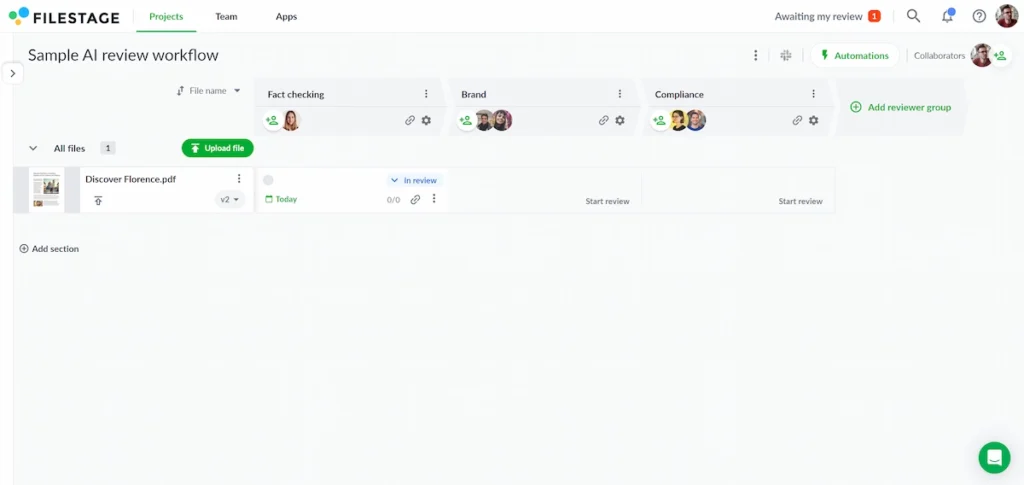
Now, let’s talk about the first step in that process: fact checking.
AI systems sometimes present errors as facts. This is known as AI hallucination. So when reviewing a piece of AI-generated content, highlight all the facts – you know, numbers, statistics, things like that. Then look them up one by one to check that they’re accurate.
By making this the first round of your review process, you can be sure that everything is factually accurate before getting into things like tone, style, and compliance.
4. Make sure your text and images are aligned with your brand style
Once you’ve fact-checked your content and made sure everything is accurate, it’s time to look at how it measures up against your brand guidelines.
By setting up a dedicated reviewer group, you can collect focused feedback on things like:
- Tone of voice
- Language and structure
- Fonts and typesetting
- Layouts
- Image styles
And anything else that helps make your brand feel true and authentic to your audience.
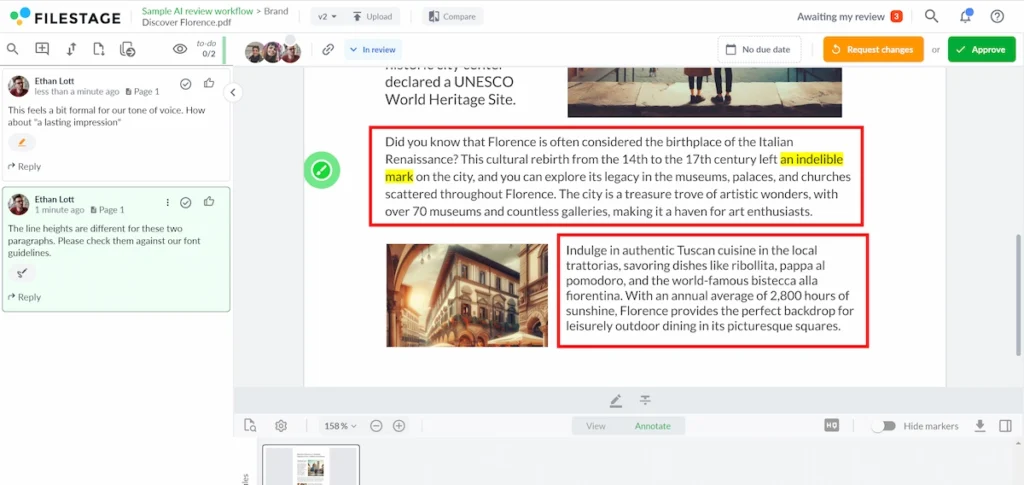
5. Check that you aren’t violating any copyright laws
Last but not least, copyright.
Copyright is one of the biggest talking points in AI right now. And to be totally honest, the whole thing is a mess.
Have tech companies infringed copyright laws by training their tools on other people’s creative work? Do you own the rights to any copy or images you generate? If your AI-generated content closely resembles a real piece of work, could you be sued?
All of these questions are very up in the air right now. But, as users, it’s that last question we need to worry about the most. That’s why it’s so important to have a legal and compliance step in your review process.
With tools like Bing Image Creator, it’s incredibly easy to generate images in the style of another artist. Sometimes even by accident. So by including this step in your review process, your legal experts can double check all your content for copyright infringement.
How? One good way is to search your AI-generated images using Google Lens. If the results all come from the same artist or you spot a close resemblance with one particular image, you should probably change it.
And for text, try Grammarly’s Plagiarism Checker.

Final thoughts
Our latest report on the impact of AI found that 42% of marketing professionals use it daily or weekly to create their content.
When digging into this, we found that 73% feel AI will lead more people to take on tasks outside their skillset. And, because of that, 62% say it will increase the importance of content reviews.
So by following our five steps, you can build a robust review process that makes sure all your content is on brand and compliant – no matter who created it!
If you’d like to try setting up your process in Filestage, start a free trial today.

